- Home
- KL City Bus
Go KL City Bus
Free Bus Service
(updated 2024)
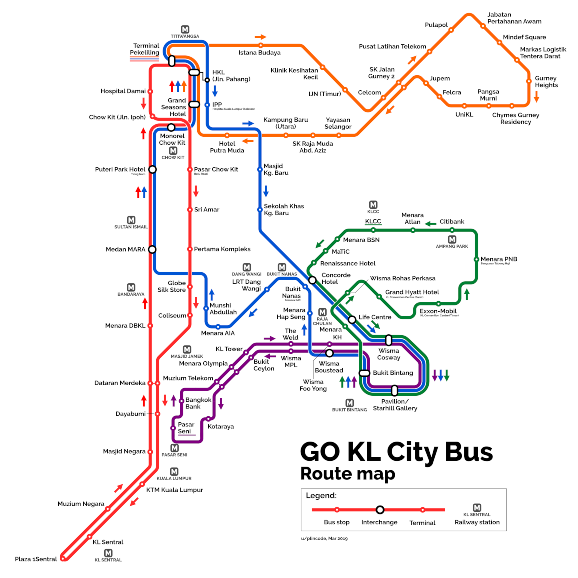
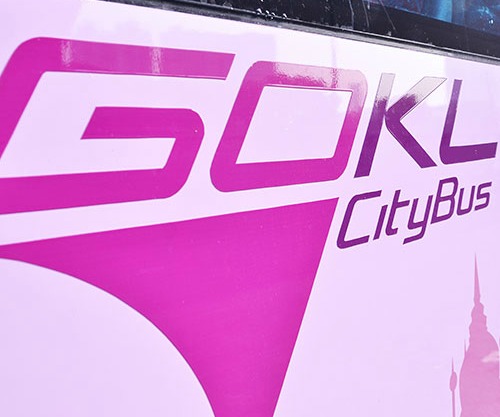
Background
In September 2012, the Government introduced Go KL City Bus, a convenient FREE bus service for both visitors and residents of Kuala Lumpur. Originally with two routes, the network was expanded in May 2014 with the addition of a further two routes and a fifth Orange Route was added in 2019. Since then, a further six routes have been added (Pink, Turquoise, Maroon, Chocolate, Parrot-Green and Grey) but since these are mostly feeder routes serving high density public housing projects, tourists need only concern themselves with the four original routes detailed below covering the main tourist areas.
Comfortable, air-conditioned, pink coloured single-decker buses with FREE WiFi cruise circular routes covering many of the main sight-seeing attractions in the heart of the city.
The buses, which are disabled-friendly and eco-friendly (powered by compressed natural gas) run at 5 minute intervals at peak periods (weekdays 7-10am and 4-8pm) and every 10 minutes at other times.
They operate from 6am until 11pm daily.
Below are details of the first five Go - KL City Bus routes; Green Route with 14 stops, Purple Route with 15 stops, Red Route with 19 stops, Blue Route with 17 stops and Orange Route with 24 stops totalling 89 stops between them.
No Longer Free for Foreigners
From 1 January 2024 onwards, foreigners have to pay RM 1 per ride. Payment can be made by using Touch n Go or credit and debit cards. Malaysians using MyKad with the Touch n Go feature need to register at DBKL registration counters in order to continue to enjoy the free rides. Non-citizen children aged 12 and under can still enjoy free rides.
Where Does the Go - KL City Bus Stop?
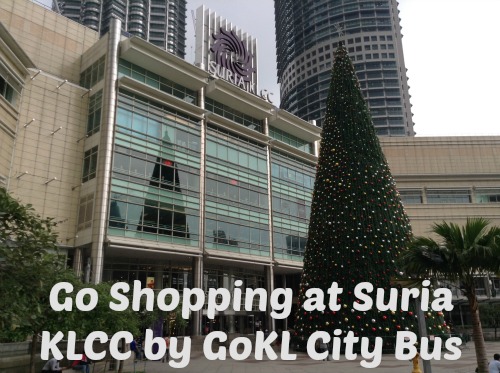
Green Route (KLCC – Bukit Bintang)
Stops At:
KLCC (for Petronas Twin Towers, Suria Mall, Petrosains, Malaysia Philharmonic, Convention Centre, Aquaria)
Angkasaraya (for British Council)
MaTiC (Malaysia Tourism Centre)
Concorde Hotel (Hard Rock Cafe, Shangri-La Hotel, Bukit Nanas Monorail Station)
Life Centre (dining & entertainment hub)
Pavilion (KL's top mall, food court and restaurants)
Starhill Gallery (more upmarket shopping, restaurants, spas etc)
Bukit Bintang (HSBC Bank, restaurants, bars especially in Changkat Bukit Bintang area, entertainment)
Menara KH (Raja Chulan Monorail Station, hotels, restaurants)
Wisma Rohas Perkasa (Beach Club, Rum Jungle)
Grand Hyatt Hotel
KL Convention Centre (Aquaria KLCC)
Citibank (Ampang Park shopping, Intercontinental Hotel, restaurants)
Menara Atlan (Kun Yam Thong Temple, hotels, restaurants)
KLCC (back to start)
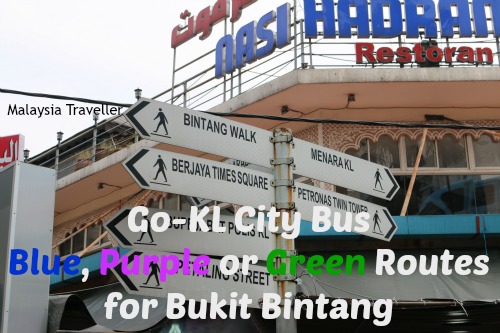
Purple Route (Pasar Seni - Bukit Bintang )
Stops At:
Pasar Seni (Central Market, Sri Mahamariamman Temple, Guan Di Temple, Chinatown)
Bangkok Bank (KL Heritage Trail, Chinatown, Dataran Merdeka)
Telekom Museum (Telekom Museum, St. John's Cathedral)
Olympia Tower
KL Tower (KL Tower, Bukit Nanas)
The Weld (Shopping, F&B outlets)
Wisma Lim Foo Yong (shopping arcade, Marco Polo restaurant)
Pavilion ( KL's top mall, food court and restaurants, Bintang Walk)
Starhill Gallery (more upmarket shopping, restaurants, spas etc)
Bukit Bintang (Bintang Walk, HSBC Bank, restaurants, bars especially in Changkat Bukit Bintang area, entertainment)
Wisma Boustead
Wisma MPL
Bukit Ceylon Junction (St. Andrew's Church)
Telekom Museum opposite (Telekom Museum)
Kota Raya(Kota Raya shopping, Petaling Street market, restaurants, Chinatown, Maybank Numismatic Museum).
Pasar Seni (back to start)
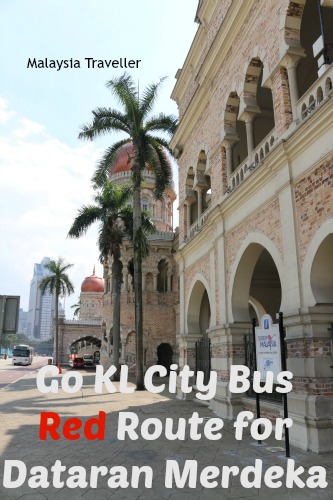
Red Route (KL Sentral - Jalan Tuanku Abdul Rahman)
KL Sentral (KL’s main railway terminus, Monorail, Nu Sentral shopping mall)
1 Sentral (office tower)
Muzium Negara (National Museum, Planetarium, KL Bird Park)
Masjid Negara (National Mosque, Islamic Museum, Police Museum)
Dataran Merdeka (KL City Gallery, Sultan Abdul Samad Building, Textile Museum)
Menara DBKL (Cathedral of St. Mary, Royal Selangor Club)
MARA Building (Sogo Department Store)
Puteri Park (Jalan Raja Laut, shops, hotels)
Chow Kit/Jalan Ipoh (shops, hotels)
Grand Season (Bio-Medical Museum)
Titiwangsa Monorail (LRT, monorail interchange and Jalan Tun Razak bus terminal)
Hospital Damai
Monorail Chow Kit (monorail station, shopping)
Pasar Chow Kit (market, shopping)
Sri Amar (shops, offices, hotels)
Pertama Kompleks (shops, Sogo)
Globe Silk Store (textile shops, Jalan Masjid India)
Coliseum (colonial era restaurant and bar)
Dataran Merdeka (KL City Gallery, Sultan Abdul Samad Building, Textile Museum)
Dayabumi (offices, Central Post Office, Central Market)
KTM Kuala Lumpur (old KL Railway Station, Majestic Hotel)
KL Sentral (back to start)
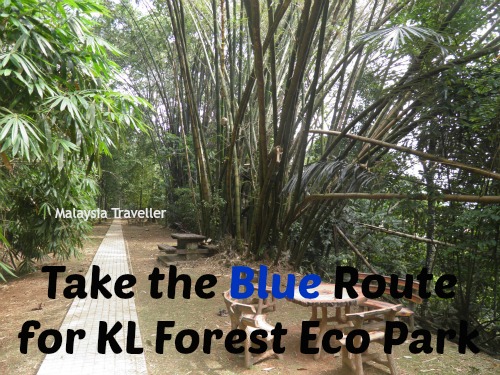
Blue Route (Medan MARA - Bukit Bintang)
MARA Building (Sogo Department Store)
Puteri Park (Jalan Raja Laut, shops, hotels)
Chow Kit/Jalan Ipoh (shops, hotels)
Grand Season (Bio-Medical Museum)
Titiwangsa Monorail (LRT, monorail interchange and Jalan Tun Razak bus terminal)
HKL Jalan Pahang (Kuala Lumpur Hospital)
IPP (Institute for Medical Research, Bio-Medical Museum)
Masjid Kampung Baru (Kampung Baru)
Sekolah Khas Kg Baru
Concorde Hotel (Hard Rock Cafe, Shangri-La Hotel, Bukit Nanas Monorail Station)
Life Centre (dining & entertainment hub)
Pavilion (KL's top mall, food court and restaurants, Bintang Walk)
Starhill Gallery (more upmarket shopping, restaurants, spas etc)
Bukit Bintang (HSBC Bank, restaurants, bars especially in Changkat Bukit Bintang area, entertainment)
Wisma Boustead
Hap Seng Tower (Brussels Beer Cafe, Hakka Republic)
Bukit Nanas (KL Forest Eco Park, KL Tower)
LRT Dang Wangi
Menara AIA (offices)
Munshi Abdullah (offices)
MARA Building (back to start)
Orange Route (Titiwangsa to Mindef)
The Orange route is one of the new feeder routes designed to help low-income users commute between residential areas and the city centre. This KL City Bus route is therefore more useful for KL residents than tourists as it passes through suburban areas, commercial and government offices rather than prime tourist attractions.
Titiwangsa (transport hub )
Istana Budaya (next door to National Visual Arts Gallery)
Klinik Kesihatan Kecil
IJN Timur
Celcom
SK Jalan Gurney 2
Pusat Latihan Telekom
Pulapol
Jabatan Pertahanan Awam
Mindef Square
Markas Logistic Tentera Darat
Gurney Heights
Chymes Gurney Residency
Pangsa Murni
UniKL
Felcra
Jupem
Yayasan Selangor
SK Raja Muda Abd. Aziz
Hotel Pudra Muda
Grand Seasons Hotel
HKL Jalan Pahang
Terminal Pekeliling
Tip For Travelling On Go KL City Bus
Being a free service means that the buses can get very busy especially at peak hours. Around 85% of the users are estimated to be Malaysians travelling to and from work. If you are a tourist it is better to avoid the rush hour crush and travel at off-peak hours.
- Home
- KL City Bus
Share this page:

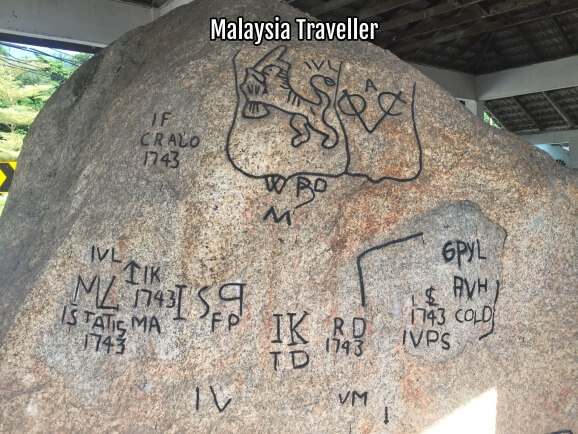


Comments
Have your say about what you just read! Leave me a comment in the box below.